
Email marketing is the most cost-effective digital marketing channel, but only if you know how to use it! These email marketing best practices will help you create engaging content, optimize for conversions, and build out a rock-solid strategy.
Following these best practices will help your business make the most of this powerful marketing channel. Whether you’re a small business just starting out with email marketing or a seasoned ecommerce pro, this list is full of helpful tips and fresh ideas to take your email marketing strategy to the next level.
24 Email Marketing Best Practices
- Know your target audience
- Create a signup form
- Segment your email list
- Design a landing page
- Keep your email list clean
- Forget about no-reply addresses
- Stop buying email lists
- Know how often to send emails
- Send personalized emails
- Set up automations
- Track performance metrics
- Link to social media
- Prepare for holiday email marketing
- Craft engaging email copy for your brand
- Optimize your subject lines
- Perfect your call to action
- Use consistent, on-brand design
- Use email templates
- Feature your customers
- A/B test your email content
- Know the rules: GDPR
- Use double opt-in
- Add an unsubscribe button
- Consider a dedicated IP address
Email List Best Practices
Any effective email marketing strategy starts with the contact list. After all, what good is an email without anyone to send it to?
1. Know your target audience
Before you even start collecting email addresses, having a solid understanding of your target audience is essential. Your email marketing strategy should be based around this group’s interests and shopping behavior.
Ask questions like, “What sets my target audience apart from others?” “How often do they like to receive email content from me?” “What tone of voice and design style resonate with them?”
If you’re starting your list from scratch, you may not know the answers to these questions right away. (We’ll get into how you get the answers in the next step.) Still, being aware of your target audience’s preferences and habits is one of the most important email marketing best practices.
2. Create a signup form
In order to collect email addresses for your contact list, you’ll need a signup form. Signup forms are helpful for a few reasons.
First, when a new subscriber gives you their email address, signup forms add their information directly to your email marketing tool and register their consent.
Second, signup forms are a great opportunity to learn more about your target audience. At the same time as new subscribers provide their contact information, ask them a few additional questions like their age, what products or services they’re interested in, or where they live.
Third, signup forms are the easiest way to legally (consensually) add subscribers to your email list. We’ll come back to this point soon.
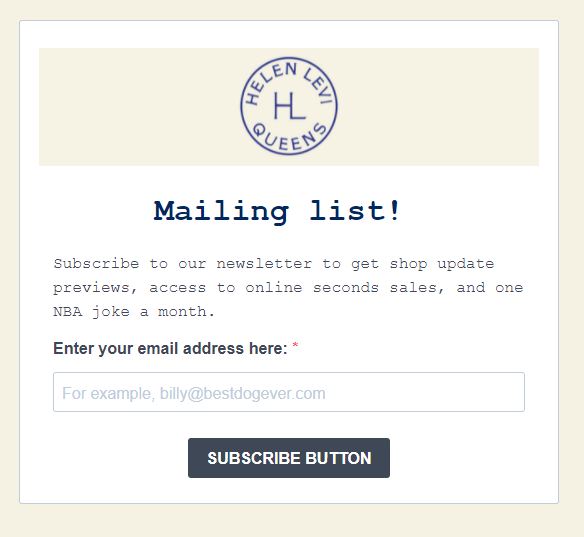
Want to get started? Learn how in our step-by-step guide on how to create an email signup form.
Looking for ideas? Check out these 20 inspiring newsletter signup examples.
3. Segment you email list
Next up we have email list segmentation — another game-changing email marketing best practice. Email segmentation is the process of grouping contacts together based on shared traits or interests.
There are four ways you can segment contacts:
- Demographic: based on biographical information about your contacts. (Age, gender, family status.)
- Psychographic: based on subjective information about your contacts’ personalities or lifestyles. (Income level, topics of interest, engagement with other brands.)
- Behavioral: based on contacts’ previous interactions with your brand. (Purchase history, account signup, website visits.)
- Geographical: based on where your contacts live.
For those kicking off their first email list, it may be too early to see the benefits of fine-tuned segments. But it’s not too early to lay the groundwork!
As we said above, think about what information would help your targeted communications. Then, either ask new signups on your form or set up tracking to record relevant behaviors.
Pro Hack
Brevo offers pre-defined customer segments to use readily in your campaigns. No need to filter, reach your customers immediately!

4. Design a landing page
Landing pages are exactly what they sound like. They’re a dedicated page on your website where new leads “land” to sign up as subscribers.
While you could send new signups to your homepage, it’s likely they’ll get lost or distracted before entering their contact information. With a dedicated landing page, the process is straightforward and encourages streamlined signups.
Be sure your landing page doesn’t have too many bells and whistles. Keep things on-brand and simple. Visitors should be able to recognize your business and easily sign up to your email list.
Take a look at our content on email list building and lead magnet ideas for more ways to grow your contact base.
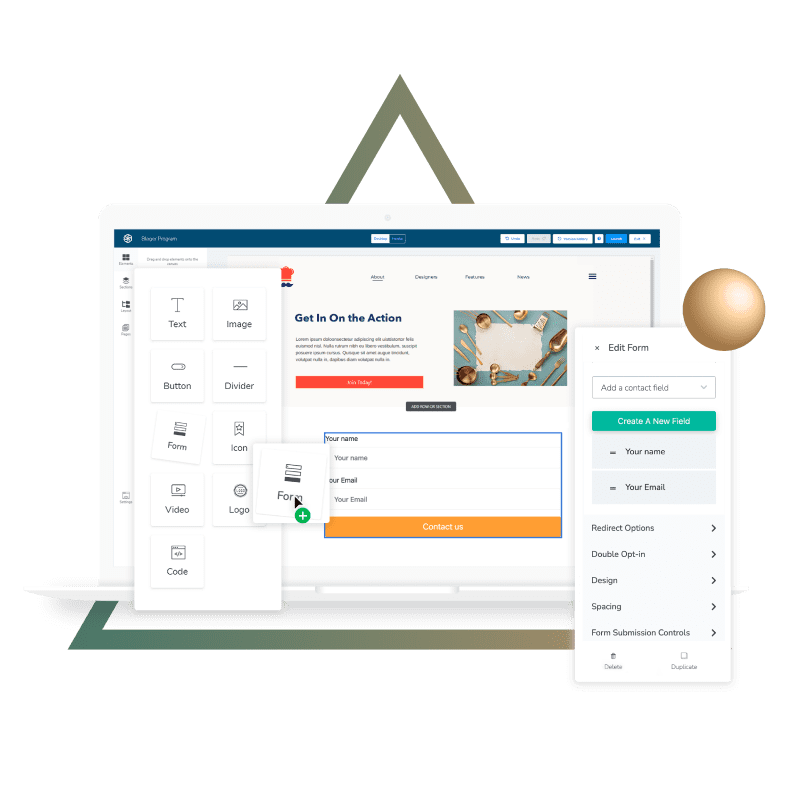
5. Keep your email list clean
Email list cleaning means regularly purging uninterested, inactive contacts and honoring subscribers’ email preferences.
Removing contacts from your list may seem counterproductive for sales. But trust us — inactive contacts who don’t respond to re-engagement campaigns aren’t doing you any favors.
In fact, they’re likely to flag your emails as spam if you don’t honor their unsubscribe request. When enough unhappy recipients flag your email campaigns as spam, your sender reputation could take a hit. This then damages your overall email deliverability, meaning fewer of your actually engaged audience will receive your campaigns.
So, there’s no use in holding out hope for those inactive contacts. If they’ve ignored your re-engagement campaigns, then you’ll have to learn to let go.
6. Forget about noreply email addresses
A “noreply” is an email address businesses use to block their contacts from writing back to them. They typically look something like: [email protected].
This faceless, unresponsive type of sender is becoming less and less common. Still, there are plenty of businesses who use it. But they really shouldn’t…
Marketing communications are a two-way street. As a business, you can’t just bombard consumers with promotional content. You’re there to assist them in addition to selling a product or service.
When a contact sees a noreply address, your brand comes across as uninterested and unwilling to help out.
Instead, you should allow recipients to respond to campaigns and transactional emails via a company email address (like [email protected]) or an employee’s (like [email protected]).
This not only opens the door for quality customer service. It also contributes to building strong relationships with your audience.
In short, a noreply email address is something to avoid.
7. Stop buying email lists
Of all the email marketing best practices we’ll go through, this one may be the most important — do not buy email lists.
Buying your list is often seen as a shortcut to traditional lead generation. Here are some reasons why that’s not recommended and just downright false:
- Sending unsolicited emails is illegal in many countries thanks to GDPR and CANSPAM.
- Sending unsolicited emails means you’ll likely be flagged as a spammer, damaging your sender reputation and deliverability.
- Most email marketing services refuse to store purchased email lists.
So when you get right down to it, buying an email list won’t really generate any leads because whatever you send them is unlikely to be delivered. And even if it is, there’s a good chance it’ll be flagged as spam.
For more details, check out this article on why you should never buy an email list.
Email Marketing Strategy Best Practices
Once your email list is up and running, start thinking about your overall email marketing strategy. What is the goal of each campaign? What features will you need to accomplish those goals? What type of content will you send and how often?
8. Know how often to send emails
Knowing how often to send email campaigns is one of the more challenging best practices to master. This is because the “correct” frequency is different for every business.
On the one hand, you don’t want to overwhelm your contacts with promotional emails multiple times per week.
On the other hand, irregular or erratic sending patterns can have an impact on your sender reputation and email deliverability. Though this is more of a long-term risk. Taking some time off in the summer, for example, won’t have a huge impact.
The surest way to nail your emailing frequency is by asking new subscribers how often they want to receive your campaigns when they sign up.
As a very general rule, sending mass campaigns (to most or all of your list) every two to four weeks is a safe rhythm to follow.
Speaking of timing, you may also want to consider what time of day and day of the week you send out campaigns. Brevo conducted a study on the best time to send an email. Take a look to find out what times/days optimized email open rates and click-through rates.
Another option when it comes to timing your email campaigns is Brevo’s Send Time Optimization feature. It analyzes your contacts’ engagement with previous campaigns and chooses the best time to individually deliver each email within a 24-hour timeframe.
9. Send personalized emails
Personalizing your email content is easy to do and has huge benefits when it comes to email engagement.
One of the easiest ways to personalize your emails is by including contacts’ first names in the greeting of your message.
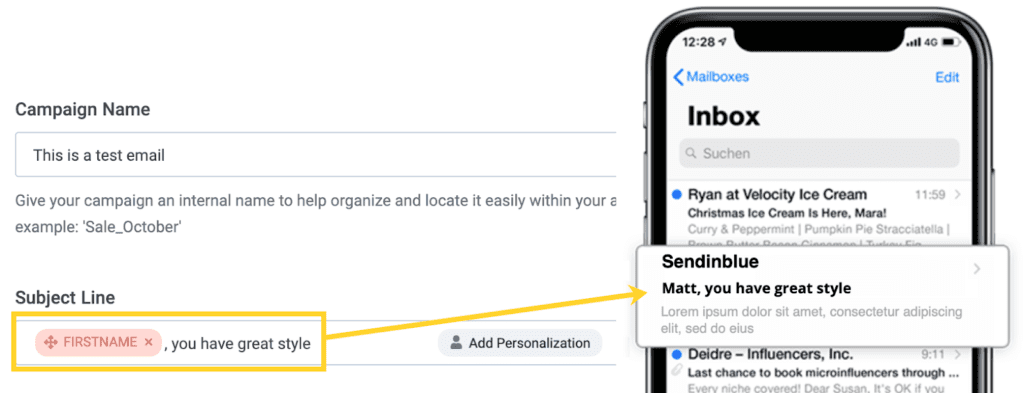
For ecommerce retailers, connecting your email marketing tool to your online shop opens up loads of possibilities, from abandoned cart emails to personalized discount codes for loyal customers.
For more ideas on how to bring your targeted email content to the next level, check out our post on email personalization tips.
10. Set up automations
Email automation is a vast topic. There are countless ways to use the feature to save time and boost sales.
Basically, email marketing automation allows you to send emails to specific contacts based on actions they take. For instance, you could set up automated emails to be sent out on customers’ birthdays.
Onboarding workflows are a common type of automation used by SaaS companies. They start by sending a welcome email after registration and gradually help users get to know the platform through a series of follow-up emails programmed at certain intervals.
Most email marketing software come with easy-to-use workflow editors, meaning you don’t need any technical expertise to set up your own automations!
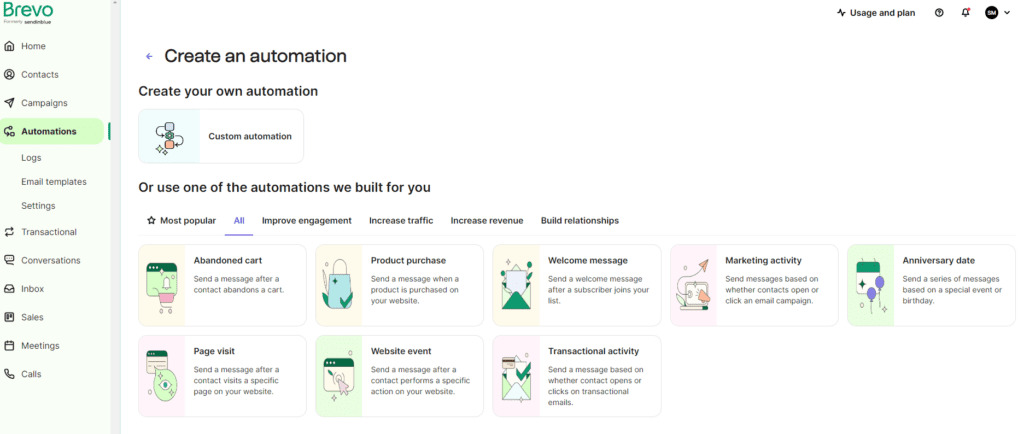
For more inspiration on what you can do with email marketing automation, take a look at:
- 20 Best Email Automation Examples for Marketing Workflows
- 10 Best Email Automation Tools for Growing Businesses
11. Track performance metrics
Keeping track of your campaigns’ performance is crucial to the continuous improvement of your overall marketing strategy. But which metrics should you be following?
Obviously, open rates and click-through rates are major ways you know how well your campaigns are doing.
You should also be paying attention to your campaigns’ unsubscribe rates and bounce rates. There are two types of bounces to be aware of:
- Soft bounces are temporary delivery failures. (The recipient’s server is down, or their mailbox is full.)
- Hard bounces mean the email will never be delivered. (The email address is incorrect or no longer exists.)
For more information on tracking your campaigns’ performance, take a look at our post on email marketing benchmarks and KPIs.
Another important piece of data to keep track of is your conversion rate, specifically the conversions linked to your email marketing campaigns. Brevo allows you to connect with your online store to see exactly how much revenue you made on each email campaign. Learn how to set it up with this Help Center article.
12. Link to social media
Your email marketing campaigns are great places to link to your social media accounts. Add icon buttons like this for a subtle but noticeable plug to your social channels.
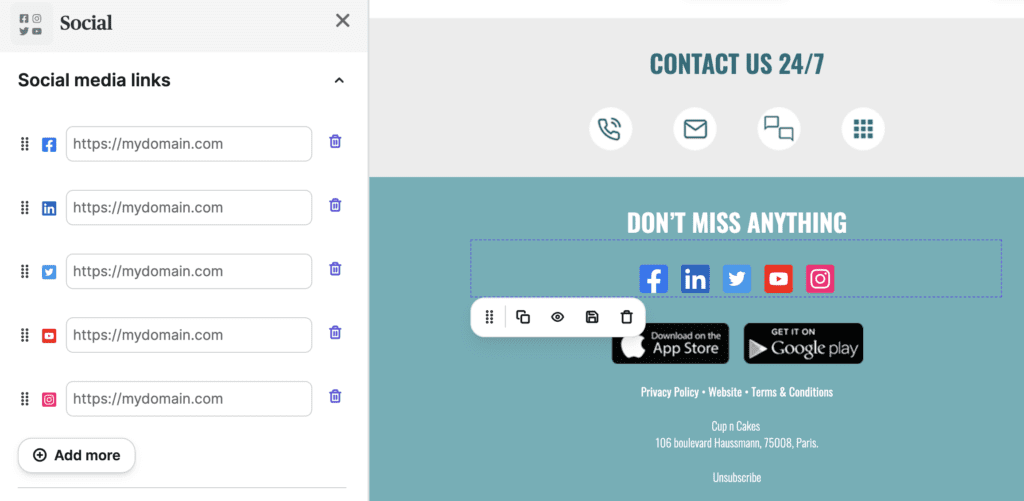
Second, try running an engagement campaign on social media spotlighting your customers and their purchases. This is called user generated content and is a great marketing technique using social proof.
13. Prepare for holiday email marketing
The holiday season is a major sales period regardless of the channels you use. That said, email marketing is one of the best places to run your Black Friday campaigns.
Black Friday sales have a lot of build up. Consumers have come to expect some pretty serious discounts and deals the Friday after Thanksgiving. To make the most of this momentum, start your campaigns early.
Use automated workflows and segmentation to give your loyal customers a sneak peek at this year’s biggest promotions. Re-engage inactive contacts with personalized discounts for the holidays.
When it comes to the holidays themselves, be sure to send your audience warm wishes and thanks for their loyalty.
Check out these articles for holiday-specific tips and tricks:
- 10 Holiday Email Marketing Strategies to Boost Sales
- How to Cook Up the Perfect Thanksgiving Email Campaign
- 8 Christmas Newsletter Ideas & Examples to Wow Your Subscribers
- 3 Steps to Creating an Outstanding Valentine’s Day Newsletter
- 40 Black Friday & Cyber Monday Email Subject Lines to Boost Your Open Rate
- 12 Black Friday Marketing Strategies to Beat the Competition
- Halloween Email Marketing: How to Make Monster Sales This Fall
- 6 Cyber Monday Email Examples (& Why They Work) to Improve Your Own
Email Content & Design Best Practices
14. Craft engaging email copy for your brand
Spend some time giving thought to your email copy. Even if you’re not a copywriter by trade, you too can craft engaging copy that converts!
The most important piece of advice we have is this: offer value to your subscribers. They’ve given their consent to be on your email list because they expect to get something out of it. Every email you send should focus on providing value to your customers in the form of promotions, blog content, webinar invitations, personalized offers, etc.
As for the writing itself, your email copy should be:
- On-brand: Aim to embody your brand’s identity in your tone of voice. This helps your subscribers have something personal to connect with and reinforce the image you’re putting out into the world. Are you funny and playful? Or more serious and direct? Do you use emojis or not at all?
- Conversational: Keep things casual and accessible, like a conversation. Your contacts get a lot of emails. Reading your email copy shouldn’t feel like work.
- To-the-point: Be direct and tell customers what you want them to know right away. Again, they likely won’t be spending much time on your email.
For more tips on writing top-notch email copy that converts, check out our article: 6 Email Copy Characteristics You Need to Know Today.
15. Optimize your subject lines
Of all the text within a campaign, your subject line is the most likely to be read by subscribers. Most people won’t open your email. Even fewer will read it in full. But most will read your subject line.
For this reason, you should spend some time crafting it. Here are our pointers:
- Entice and encourage subscribers to open your email with your value proposition. Tell your contacts what they’ll get out of this email and instill a sense of urgency.
- Stay away from overly promotional copy. While you want to give contacts a reason to open your email, don’t be in their faces about it. Subject lines with extreme punctuation, all caps, and over-stylized fonts don’t do well.
- Use your brand voice even when writing subject lines. It helps subscribers recognize your email and contributes to your overall brand identity.
Follow these tips and you’ll be well on your way to writing subject lines that boost open rates and drive conversions! Just be sure to keep your subject line to around 60 characters, as most email clients won’t display much more than this.
Pro tip: Take things one step further by optimizing your preheader/preview text. Check out our article to learn how: 150 Email Subject Lines: Examples, Best Practices, and More
16. Perfect your call to action
Every campaign you send needs a call to action. It’s how you tell subscribers what you want them to do — be it create an account, make a purchase, or share your brand on social media.
Your call to action should be actionable, brief, and eye-catching. Starting with a command verb is a nice way to motivate subscribers.
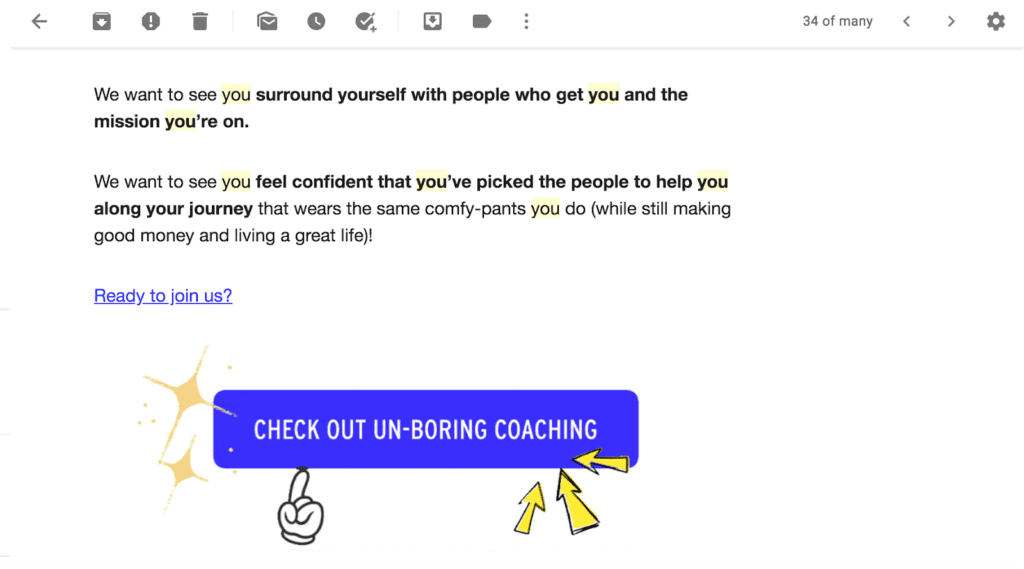
17. Use consistent, on-brand design
When it comes to the look and feel of your emails, your brand identity should shine. Of course, you want your campaigns to be aesthetically pleasing. But email marketing can and should go beyond that by contributing to your overall brand identity.
By designing branded emails, your subscribers will come to associate your business with a certain set of colors, font, images, and tone of voice. And this is no small thing. When consumers make buying decisions, they subconsciously consider your brand identity.
And when your brand identity comes across clearly in your emails, all the pieces come together for them to make a purchase.
Aside from branding, there are a few options for email design and layout:
- Inverted pyramid: Make your most important content the largest in size and put it at the top of the email. Content in the following sections should get progressively smaller.
- Z pattern: Our eyes often follow a Z pattern when reading. Try using this layout to keep subscribers engaged as they make their way through your email.
Further reading:
18. Use email templates
Wondering what’s the easiest way to design on-brand emails? Create a few email templates that you can use over and over again!
Investing some time in designing your email templates will keep your content on brand and also save you time later on. If design isn’t your thing, start with a premade template and customize it to match your brand.
Most email marketing services make this process easy with a drag-and-drop editor. No need to fuss with HTML or make sure your content displays correctly on mobile devices. Brevo offers over 40 customizable responsive templates, all for free!
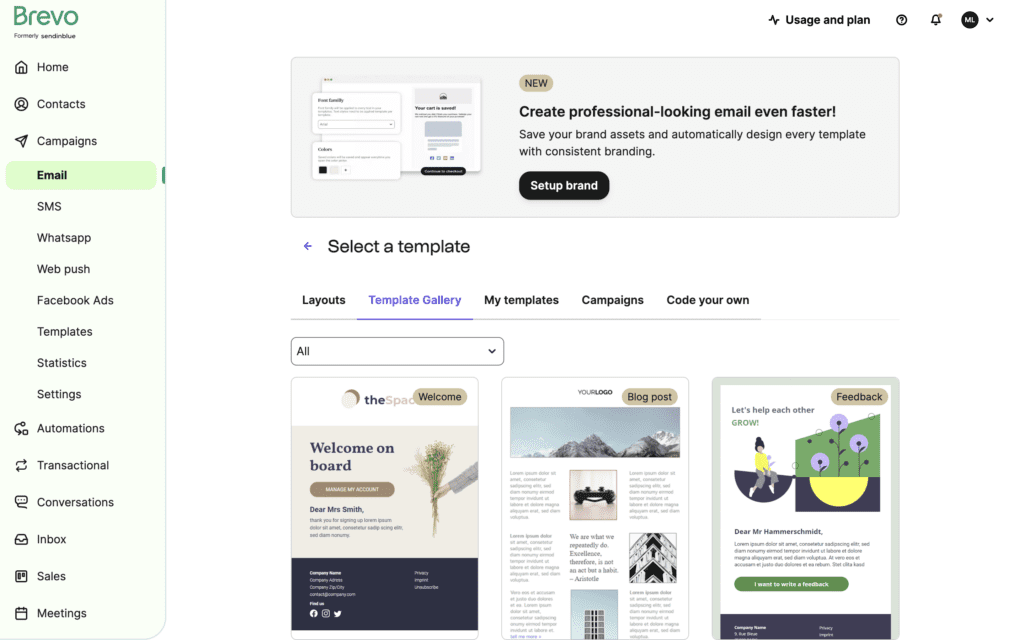
Get inspired by our rundown of the 10 best sites for free responsive email templates.
19. Feature your customers
Shine a spotlight on your customers by featuring user-generated content in your email marketing! Run an engagement campaign where you ask customers to take a selfie with your product. Or reach out to your loyal customers and ask them to leave a review.
Whatever type of content your customers have to offer is great material for your campaigns. It helps build trust in your business thanks to social proof. Consumers really believe other consumers, which is what makes user-generated content so powerful.
Take a look at this example from Fabletics:
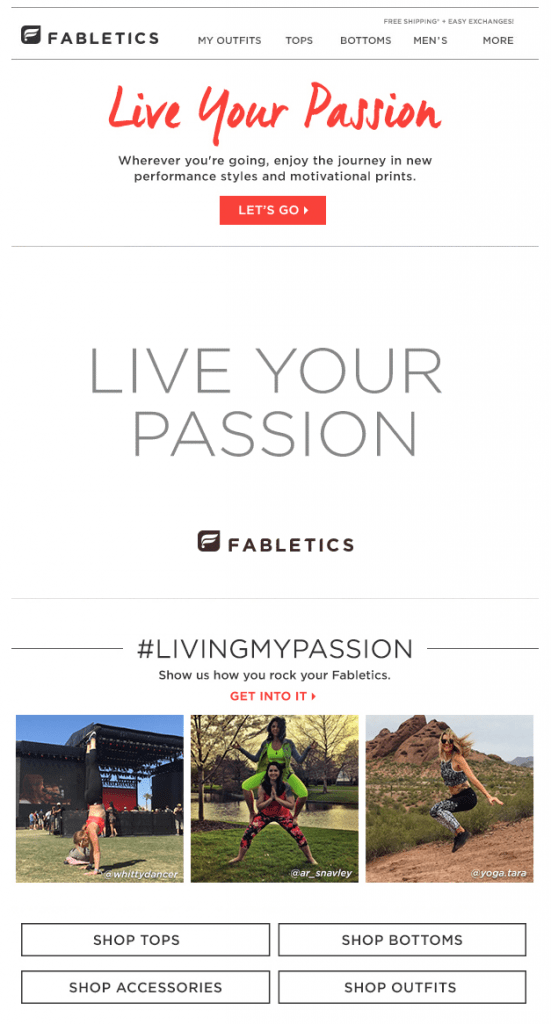
Email campaign from Fabletics showcasing user generated content in the form of customers’ instagram posts featuring their products.
20. A/B test your email content
Once you’ve put in the work creating your campaigns, it’s time to see what works best with A/B testing!
Running A/B tests on things like subject lines, email copy, and even your CTAs helps you optimize your campaigns. It’s an easy way to see what works for your email subscribers and in turn helps drive conversions.
Most email service providers come with easy-to-use A/B testing features.
Email Deliverability Best Practices
Our last set of email best practices has to do with deliverability. Don’t let all your hard work up to this point go to waste! Email deliverability is a delicate topic, but it doesn’t have to be difficult.
21. Know the rules: GDPR
GDPR is the legal framework protecting data and privacy online in the EU. While it’s not legally binding in the rest of the world, it’s a great set of guidelines to work by.
GDPR requires you to have a contact’s explicit consent (typically via a signup form) before sending them anything. While this may seem like an extra step, it pays off in the long run.
By having people sign up for your emails, you’re sure they want to hear from you and that they’re unlikely to flag you as a spammer.
To learn more about what GDPR means for your business, take a look at our infographic.
22. Use double opt-in
Double opt-in is a way of adding new subscribers to your contact list. Once someone submits their email address in a signup form, they’ll receive an email to confirm their subscription. Only when the new subscriber clicks on the link in the email will they be added to your contact list.
This process helps deliverability for two reasons. First, it weeds out any misspelled/fake email addresses that would result in hard bounces later on. Second, the extra effort of confirming their signup ensures subscribers are actually interested in your emails and are more likely to engage.
We at Brevo strongly recommend double opt-in as a way to maintain high deliverability and a strong sender reputation.
23. Add an unsubscribe button
You may not like seeing subscribers go. But trust us — keeping inactive and uninterested contacts on your list won’t do you any good.
If someone can’t easily unsubscribe from your list, they’re very likely to flag you as a spammer. This damages your sender reputation and therefore your overall deliverability. (It’s also illegal not to include an unsubscribe link in your emails!)
In the end, there’s really no use in holding on to contacts who wish to unsubscribe. Letting them go will do more for your email open rates and engagement than holding on.
24. Consider using a dedicated IP address
Many email service providers give you the option of using a dedicated IP address, rather than a shared one, for your email marketing. For these purposes, an IP address is kind of like an ID number for the server that’s sending your emails.
When an email client like Gmail receives an email message, it checks the sender IP address and its reputability before letting anything into the inbox.
A major benefit of dedicated IP addresses is that you have complete control over your reputation. It’s based entirely on your sending habits.
That said, a dedicated IP address takes a fair bit of work to set up properly. You’ll need to warm it up before you can begin sending in full force. That’s why we typically recommend dedicated IP addresses only for high-volume senders.
If you have more questions, take a look at our guide on dedicated IP addresses for email marketing.
24 Email Marketing Best Practices Later…
Email marketing is a huge topic. There are as many best practices to follow as there are email marketers. In this article, we’ve put together our top email marketing tips based on years of experience helping hundreds of thousands of clients.
To put your newfound knowledge to good use, why not try out Brevo? Our full marketing and CRM suite is perfect for beginners and experienced marketers alike. Create your free account today and get access to countless features.
Jumpstart your email strategy with BrevoFree plan includes access to all core email features, unlimited contact storage, 300 emails/day, 40+ email templates, and customizable signup forms to grow your email list. |






